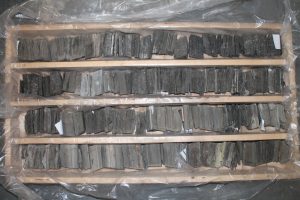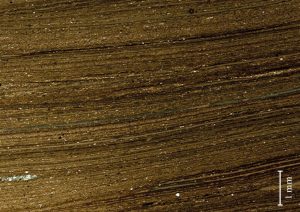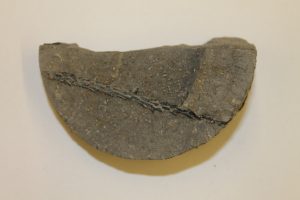In my last blog, I described the diverse world of pollen and how palynology – the study pollen, is used in geosciences. Today, I turn to another microcosmos: that of finest layers deposited at the bottom of a lake.
A large majority of geoscientists would tell you the best part of their job is field work. Despite sometimes harsh weather conditions, long hikes in wind, rain or merciless sun, many geologists enjoy the outdoors and look forward to a great rock exposure. While I very much enjoy field work myself, some of my current research brings me to the core lab at best. Here, at the University of Aberdeen, we have access to a 400 m long core of rock, which was drilled 10 years ago with the help of the Open University and University of Kiev in the Ukraine – a core drilled in the centre of the so-called Boltysh meteorite impact crater.

Part of the core recovered by drilling ancient lake sediments in the Boltysh meteorite impact crater, Ukraine.
The Boltysh crater formed about 65 My ago, which brings it in the same age range as the more prominent Chicxulub impact, which by some scientists is considered as the cause for the extinction of dinosaurs. The Boltysh crater, however, probably formed a few thousand years prior to the Chicxulub impact, and is of much smaller size. What makes this crater so interesting for us is that shortly after its formation, a lake began to form at the crater bottom, slowly filling up the entire crater with finely layered lake sediments over a period of nearly 1 million years. Importantly, these sediments cover the first 500.000 years of the earliest Palaeogene age (=Danian), which is known for its unstable climatic conditions. Understanding how climate and environment changed in the past is a crucial step in better understanding modern climate change and its short- and long-term impact on Earth.
Modern lakes typically produce very fine layers of debris at the bottom, often less than 1 mm thick. These layers, sometimes referred to as varves, may vary from year to year, and even from season to season, similar to concentric tree rings. Ancient lakes and their deposits show very similar lamination of sediment. That way, both modern and ancient lake sediments may give detailed insights into how environment and climate changed over a few years or decades – and this even from many million years ago!

Slide scanner image of very fine lamination formed during deposition of sediments at lake bottom, due to seasonal changes in sediment supply and composition (Boltysh meteorite impact crater).
The core recovered from the Boltysh meteorite impact crater reveals lamination as fine as 0.08 mm. Individual layers – or laminae, therefore need to be examined with a high-resolution microscope or core scanner to distinguish slight changes in mineral, chemical and grain size composition, as well as fossil flora and fauna content. These information are used to reconstruct how environment and ultimately climate changed through geologically short periods of time. Although 65 million years old, this core contains valuable information on how Earth responded to climate change in the past – which helps to better predict changes of our environment in modern and future times.

